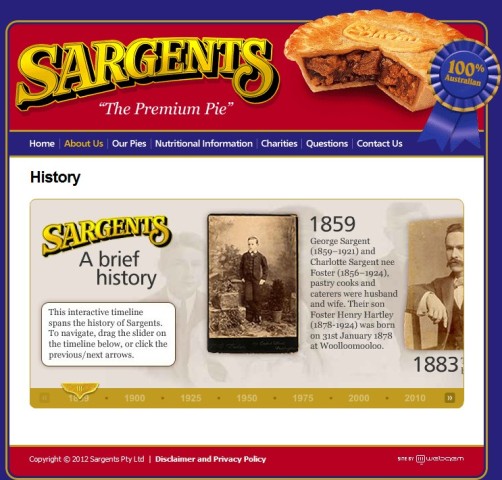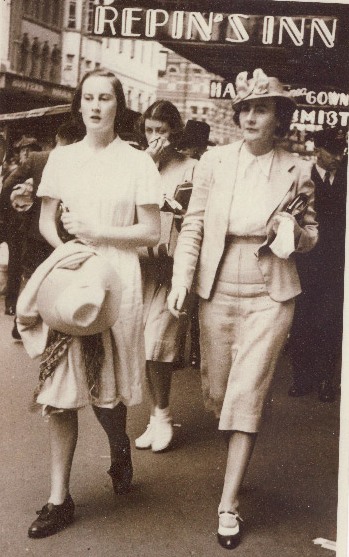September 2 - 8, 2012: Issue 74

First screen of a History of Sargents at
www.sargents.com.au/aboutus/history.cfm

Street photographer's picture of a mother and daughter in Market Street, City
Street photographer's picture of three young people in front of Sargent's at the Neutral Bay Ferry Wharf at Circular Quay 1938.
|
|
SARGENT’S TEA ROOMS, PIE SHOPS AND STREET PHOTOGRAPHERS
By George Repin
In the Thirties everyone in Sydney knew Sargent’s pies, which were sold throughout the city in the company’s Pie Shops and Tea Rooms. The premises were plain, utilitarian and clean with no attempt at fancy décor. The food, with an emphasis on bakery goods, was wholesome, filling and not expensive, coming from Sargent’s factory in Darlinghurst. Pies, sandwiches, coffee cake and walnut buns, sponge lady fingers, chocolate eclairs and, at Christmas, individual puddings were sold over the counter. The service in the tea rooms was generally cafeteria style with a counter for retail sales at the entrance. The Sargent’s shops were popular with workers in the city. A large pie with tomato sauce, a crusty bread roll with butter and a pot of tea or milk coffee provided a quick meal. Lydia Gill in her book My Town – Sydney in the 1930’s records “Sargent’s were everywhere and the only places in Sydney that sold roast beef sandwiches. I could never afford them for myself, but when purchasing lunch for the boss, only the best would do.”
The business had grown from a small shop in Surry Street in 1889. The first of many shops in the Sydney Metropolitan area opened in 1914 and the chain established by George Sargent and his wife Charlotte flourished. They died in the 1920s but tea rooms continued to open from 1924 to1960.
An interactive timeline spanning the history of Sargent’s can be seen at www.sargents.com.au/aboutus/history.cfm
The largest Sargent’s occupied several floors of a building on the south side of Market Street near the State Theatre. A very large tea room, in the usual Sargent’s style, with counters at the front for take away sales occupied the ground floor. On the next floor, which could be reached by an elevator, was the main dining room with spotless white table clothes and gleaming silver. Lydia Gill describes the menu as “bouillon or consomme, lamb and mint sauce and three vegetables, roast beef with Yorkshire pudding or roast pork with crackling and apple sauce, then sweets, fruit salad and cream, apple pie and cream, baked bread and butter custard or steamed pudding. All this with roll and butter and coffee or tea for 1s 6d.” (1s 6d became 15c on decimal conversion) The next floor provided catering facilities for functions including weddings. When the Rotary Club of Sydney ceded part of its territory for the establishment of the Rotary Club of South Sydney in 1946 the Charter meeting of the new club was held at Sargent’s, and the club continued to meet there until it moved to the dining room at Mark Foy’s Department Store in Liverpool Street. The Sargent’s shops started to close in 1962 and by 1964 all had gone.
Street Photographers
Another feature of street life in the Sydney CBD during the Thirties and Forties was the activity of street photographers, usually with Leica cameras. They watched for people on an outing in the city who might be likely to order prints of their photographs. Fairly obvious prospects were two women together, a father and son, a mother and daughter or a group on an outing. The subjects were handed a numbered card with the address of the Company where proofs could be seen and prints ordered. There were two main companies – Leicamat and Leicagraph.
Such photographs, which many older people still have, reflect the customs of the time. The men are invariably dressed in suits, usually with waistcoats, and felt hats. The women all wear hats and gloves. Even school girls wore gloves because in those days no self respecting lady would dream of “coming into town” without a hat and gloves. What a different scene it is in central Sydney today!
The backgrounds, too, are interesting. The shops, and particularly illuminated signs hanging from the awnings, provide reminders of businesses long since gone – names such as Rigney’s Shoes, McDowell’s, Fernandes’ Fish Café, Repin’s Coffee Inns and Cahill’s Restaurants can be seen above the people in the photographs.
Street photographer's picture of a businessman in the city c.middle 1930s
Copyright George Repin, 2012. All Rights Reserved.